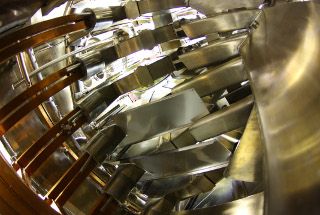The Australian Plasma Fusion Research Facility (APFRF, formerly the National Plasma Fusion Research Facility) is a uniquely versatile plasma research facility, located in the Research School of Physics and Engineering within the Australian National University (ANU) in Canberra. The H-1 heliac is the Australian focus of basic experimental research on magnetically confined plasma, important in developing fusion energy, a clean, virtually inexhaustible energy source that powers the sun and stars. H-1 is capable of accessing a wide range of plasma configurations or shapes, and utilising the associated state-of-the-art power and measurement systems that allow fundamental studies of plasma, the fourth state of matter. In 2009, under the Australian Government's Super Science Initiative, $7 million was allocated to upgrade the Facility.
Plasma – ionised gas – makes up 99% of the visible universe, and plasma phenomena are important in everything from stars and space exploration to the processing of electronic materials.
Plasma physics is thus a highly interdisciplinary endeavour because of the range of physics areas it encompasses (fluid, atomic, electromagnetic, optical and surface physics) and the diverse technologies employed in plasma experiments (electronics, radio-frequency technologies, magnetics, lasers, microwaves and spectroscopy).
The facility was developed from the ‘H-1 Heliac’ toroidal stellarator experiment in the Research School of Physics and Engineering at the Australian National University. The innovative plasma geometry and unique flexibility of the heliac allows investigation of basic plasma physics, and exploration of ideas for improved design of the fusion power stations that will follow the ITER international fusion experiment.

The objectives of this facility are to provide:
- an experimental facility with which Australian scientists, technologists and engineers can contribute to the world-wide effort to develop fusion as a future source of energy
- opportunities for advanced research training for students of science and technology
- a platform for the development of novel technological ideas that can be spun off for industrial use.
















